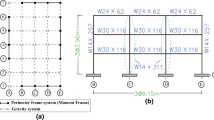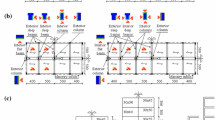Abstract
A ten storey steel office building, designed for a low-risk zone under the former Italian seismic code and in line with Eurocodes 1 and 3, is considered as test structure. More specifically, the dynamic response of the test structure in a no fire situation is compared with what would happen in the event of three fire scenarios, on the assumption that the fire compartment with a uniform temperature is confined to the area of the first (i.e. F1), fifth (i.e. F5) and tenth (i.e. F10) level, with the parametric temperature–time fire curve evaluated in line with Eurocode 1. For each fire scenario, two retrofitting structural solutions are examined to upgrade the fire damaged test structure, by inserting diagonal steel braces with or without viscoelastic dampers along the perimeter of the level where the fire compartment is hypothesized only. Frame members are idealized by a bilinear model, which allows the simulation of the nonlinear behaviour under seismic loads, while an elastic linear law is considered for diagonal braces. Finally, viscoelastic dampers are idealized by means of a frequency-dependent model obtained as an in-parallel-combination of two Maxwell models and one Kelvin model. Dynamic analyses are carried out in the time domain using a step-by-step initial stress-like iterative procedure, assuming time histories of wind velocity, based on an equivalent spectrum technique, and artificial accelerograms, whose response spectra match those adopted by Italian seismic code. Results highlight the reliability of the VEDBs to control discomfort and deformability thresholds, under wind loads, and damage and buckling thresholds, under seismic loads, especially when F1 and F5 fire scenarios are considered.


















Similar content being viewed by others
References
Wald F, Vácha J, Wang YC (2010) Protecting, strengthening and repairing fire damaged structures. Urban habitat constructions under catastrophic events: COST C26 action final report
Kirby BR, Lapwood DG, Thomson G (1986) The reinstatement of fire damaged steel and iron framed structures. British Steel Corporation (now Corus), London, pp 1–79
Della Corte G, Landolfo R, Mazzolani FM (2003) Post-earthquake fire resistance of moment resisting steel frames. Fire Saf J 38:593–612
Zaharia R, Pintea D (2009) Fire after earthquake analysis of steel moment resisting frames. Int J Steel Struct 9(4):31–42
Knobloch M, Somaini D, Pauli J, Fontana M (2012) Numerical analysis and comparative study of the cross-sectional capacity of structural steel members in fire. J Struct Fire Eng 3(1):19–36
Kodur V, Naser MZ (2015) Effect of local instability on capacity of steel beams exposed to fire. Thin-Walled Struct 111:31–42
Wang W, Kodur V, Yang X, Li G (2014) Experimental study on local buckling of axially compressed steel stub columns at elevated temperatures. Thin-Walled Struct 82:33–45
Mashhadiali N, Gholhaki M, Kheyroddin A, Zahiri-Hashemi R (2016) Analytical evaluation of the vulnerability of framed tall buildings with steel plate shear wall to progressive collapse. Int J Civil Eng. doi:10.1007/s40999-016-0044-z
Wang W-Y, Liu B, Kodur V (2013) Effect of temperature on strength and elastic modulus of high-strength steel. J Mater Civ Eng 25(2):174–182
Tao Z, Wang X, Uy B (2013) Stress–strain curves of structural and reinforcing steels after exposure to elevated temperatures. J Mater Civ Eng 25(9):1306–1316
Mazza F, Fiore M (2015) Comparative study of the wind and earthquake dynamic responses of fire exposed steel framed buildings. COMPDYN 2015. In: 5th ECCOMAS thematic conference on computational methods in structural dynamics and earthquake engineering, Crete Island, Greece, May 25–27, paper n. 490
Foti D, Diaferio M, Nobile R (2013) Dynamic behavior of new aluminum-steel energy dissipating devices. Struct Contr Health Monit 20(7):1106–1119
Christopoulos C, Filiatrault A (2006) Principles of passive supplemental damping and seismic isolation. IUSS Press, Istituto Universitario di Studi Superiori di Pavia, Italy
Symans MD, Charney FA, Whittaker AS, Constantinou MC, Kircher CA, Johnson MW, McNamara RJ (2008) Energy dissipation systems for seismic applications: current practice and recent developments. J Struct Eng 134(1):3–21
Sorace S, Terenzi G (2009) Fluid viscous damper-based seismic retrofit strategies of steel structures: General concepts and design application. Adv Steel Construct 5:322–339
Mazzolani FM, Della Corte G, D’Aniello M (2009) Experimental analysis of steel dissipative bracing systems for seismic upgrading. J Civil Eng Manag 15(1):7–19
Mazza F (2015) Comparative study of the seismic response of RC framed buildings retrofitted using modern techniques. Earthq Struct 9(1):29–48
Baratta A, Corbi I, Corbi O, Mastorakis N (2015) Strategies for the protection from structural failures under seismic events. Int J Mech 9:69–76
Mazza F, Vulcano A (2014) Equivalent viscous damping for displacement-based seismic design of hysteretic damped braces for retrofitting framed buildings. Bull Earthq Eng 12(6):2797–2819
Mazza F (2014) Displacement-based seismic design of hysteretic damped braces for retrofitting in-plan irregular r.c. framed structures. Soil Dyn Earthq Eng 66:231–240
Mazza F, Mazza M, Vulcano A (2015) Displacement-based seismic design of hysteretic damped braces for retrofitting in-elevation irregular r.c. framed structures. Soil Dyn Earthq Eng 69:115–124
Mazza F, Vulcano A (2011) Control of the earthquake and wind dynamic response of steel-framed buildings by using additional braces and/or viscoelastic dampers. Earthq Eng Struct Dyn 40(2):155–174
Christopoulos C, Montgomery M (2013) Viscoelastic coupling dampers (VCDs) for enhanced wind and seismic performance of high-rise buildings. Earthq Eng Struct Dynam 42:2217–2233
Sivandi-Pour A, Gerami M, Kheyroddin A (2016) Uniform damping ratio for non-classically damped hybrid steel concrete structures. Int J Civil Eng 14(1):1–11
Mazza F, Vulcano A (2007) Control of the along-wind response of steel framed buildings by using viscoelastic or friction dampers. Wind Struct 10(3):233–247
Italian Ministry of Public Works (DM96) (1997) Norme tecniche per le costruzioni in zone sismiche e relative istruzioni, D.M. 16-01-1996 and C.M. 10-04-1997, n. 65/AA.GG
Eurocode 1 (2004) Actions on structures—Part 1-2: General actions, actions on structures exposed to fire. C.E.N., European Committee for Standardization, October 2004
Eurocode 3 (2005) Design of steel structures—Part 1-1: General rules and rules for buildings. Part 1-2: General rules, structural fire design. C.E.N, European Committee for Standardization, December 2005
Mazza F, Vulcano A (2010) Nonlinear dynamic response of r.c. framed structures subjected to near-fault ground motions. Bull Earthq Eng 8:1331–1350
Mazza F, Mazza M (2010) Nonlinear analysis of spatial framed structures by a lumped plasticity model based on the Haar-Kàrmàn principle. Comput Mech 45:647–664
Mazza F (2014) A distributed plasticity model to simulate the biaxial behaviour in the nonlinear analysis of spatial framed. Comput Struct 135:141–154
Mazza F, Mazza M (2013) Nonlinear modeling and analysis of r.c. spatial frames to study the effects of the vertical component of near-fault ground motions. In: COMPDYN 2013, 3rd ECCOMAS thematic conference on computational methods in structural dynamics and earthquake engineering, Corfù, Greece, May 25–28, paper n. 322
ISOTC 98SC 3 International Standard Organization (1990) Wind loads on structures, Berlin, Germany
Italian Ministry of Infrastructures (NTC08) (2009) Nuove norme tecniche per le costruzioni e relative istruzioni, D.M.14-01-2008 e Circolare 02-02-2009, n. 617/C.S.LL.PP
ISO 834 International Standard (1999) Fire resistance tests, ISO 834-1 Test conditions. Provided by IHS under license with ISO: 31, Genève, Switzerland
Mazza F (2015) Seismic vulnerability and retrofitting by damped braces of fire-damaged r.c. framed buildings. Eng Struct 101:179–192
Mazza F (2015) Nonlinear incremental analysis of fire-damaged r.c. base-isolated structures subjected to near-fault ground motions. Soil Dyn Earthq Eng 77:192–202
IS FUOCO (2016) Calculation of the fire resistance of structural elements. CDM DOLMEN. Torino (Italy). http://www.cdmdolmen.it
Shen KL, Soong TT (1995) Modeling of viscoelastic dampers for structural applications. J Eng Mech 121:694–701
Kasai K, Munshi JA, Lai ML, Maison BF (1993) Viscoelastic damper hysteretic model: theory, experiment and application. In: Proceedings of seminar on seismic isolation, passive energy dissipation and active control, San Francisco (California), vol 2, pp 521–532
Uriz P, Filippou FC, Mahin SA (2008) Model for cyclic inelastic buckling of steel braces. J Struct Eng 134(4):619–628
D’Aniello M, La Manna Ambrosino G, Portioli F, Landolfo R (1993) Modelling aspects of the seismic response of steel concentric braced frames. Steel Compos Struct Int J 15(5):539–566
Hsiao P-C, Lehman DE, Roeder CW (2013) A model to simulate special concentrically braced frames beyond brace fracture. Earthq Eng Struct Dyn 42:183–200
Solari G (1998) Equivalent wind spectrum technique: theory and applications. J Struct Eng 114:1303–1323
Gasparini D, Vanmarcke E (1976) Simulated earthquake motions compatible with prescribed response spectra. Dept. of Civil Eng, Massachusetts Institute of Technology, Massachusetts
Simiu E, Scanlan R (1996) Wind effects on structures. Wiley, New York
Author information
Authors and Affiliations
Corresponding author
Rights and permissions
About this article
Cite this article
Mazza, F., Fiore, M. & Mazza, M. Dynamic Response of Steel Framed Structures Fire-Retrofitted with Viscoelastic-Damped Braces. Int J Civ Eng 15, 1187–1201 (2017). https://doi.org/10.1007/s40999-016-0134-y
Received:
Revised:
Accepted:
Published:
Issue Date:
DOI: https://doi.org/10.1007/s40999-016-0134-y




